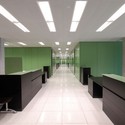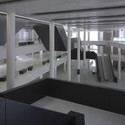
-
Photographs:Christian Richters, Joan Argelés
-
Manufacturers: Andreu Barberá, Desmon, Lanxess Bayferrox
-
Lighting Consultant: Artecluminotecnia, Arup, Florence Lam, Bob Venning, Maurici Ginés
-
Structures: Brufau, Obiol, Moya i Associats, Jane Wernick Associates, Jane Wernick, Agustí Obiol
-
Landscape Consultant: Wirtz International, Manuel Colominas, Nico Mortier, Juan Remon, Peter Wirtz
Previously, the various legal departments of the governments of Barcelona and l’Hospitalet were scattered in 17 buildings across the two cities, with functional frustrations for both users and employees. A new conjoined City of Justice will improve efficiency and allow working spaces to adapt and absorb the constant transformation of the judicial body as well as provide reserve space for future growth.

The site is at the border of the two cities of Barcelona and l’Hospitalet on a site which was previously a military barracks. It is located adjacent to both Gran Via, a major access route into the centre of Barcelona from the south, and Carrilet, an artery leading to l’Hospitalet. The position provides optimum accessibility to the city and major metropolitan routes, on both public and private transport.

The principle proposition of the project breaks down the massive programme requirements (330,000 sqm) into a series of separate but interrelated blocks on a public plaza, giving a spatial composition that attempts to break the rigid and monolithic image of justice. The proposal also attempts to provide equilibrium to the relationships between the different working areas, public areas and landscape.

A group of four large judicial buildings are situated around the perimeter of a linking concourse building. They generally contain courtrooms at ground floor and a further three floors. All of these floors are accessed directly from the concourse building which acts as a filter. The concourse building also gathers people at the start and completion of their judicial visit within a central public room, which overlooks the exterior plaza.

Four other independent buildings comprise a judicial services building for l’Hospitalet, a forensic sciences building and two commercial buildings with retail facilities at ground floor. A further building is planned to contain both residential and commercial retail activities.

All eight buildings are conceived as formally restrained blocks with load bearing coloured concrete ‘cage’ facades. Each building has a different and contrasting, although muted colour tone. The concourse building has a more free form plan with deep exposed concrete slabs and woven mesh screens in front of frameless glazing. The project includes the desin of all public, courtroom and office interiors.







































